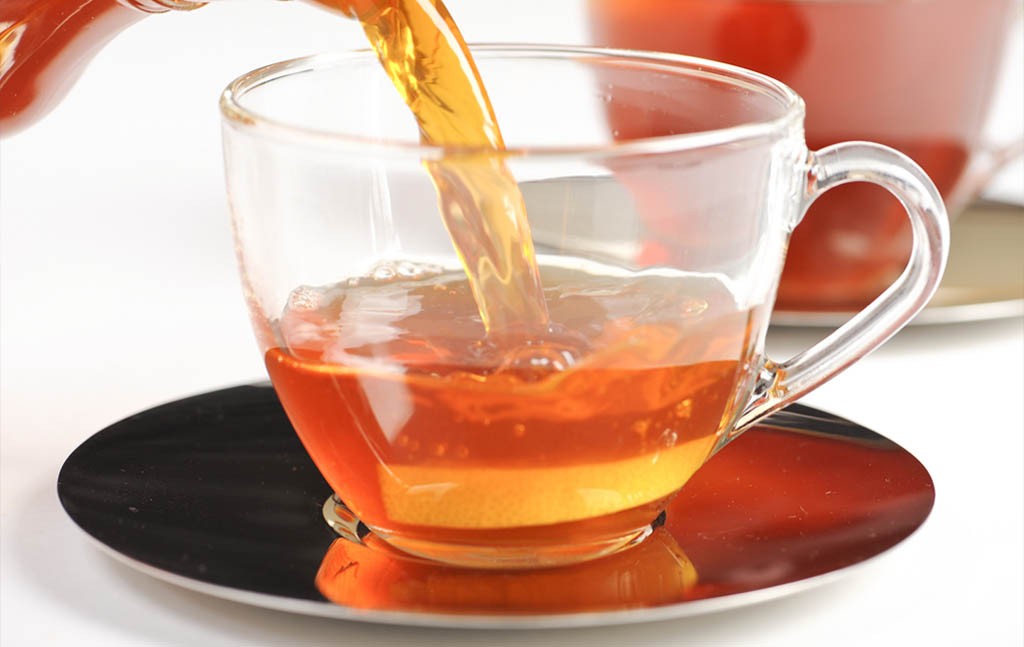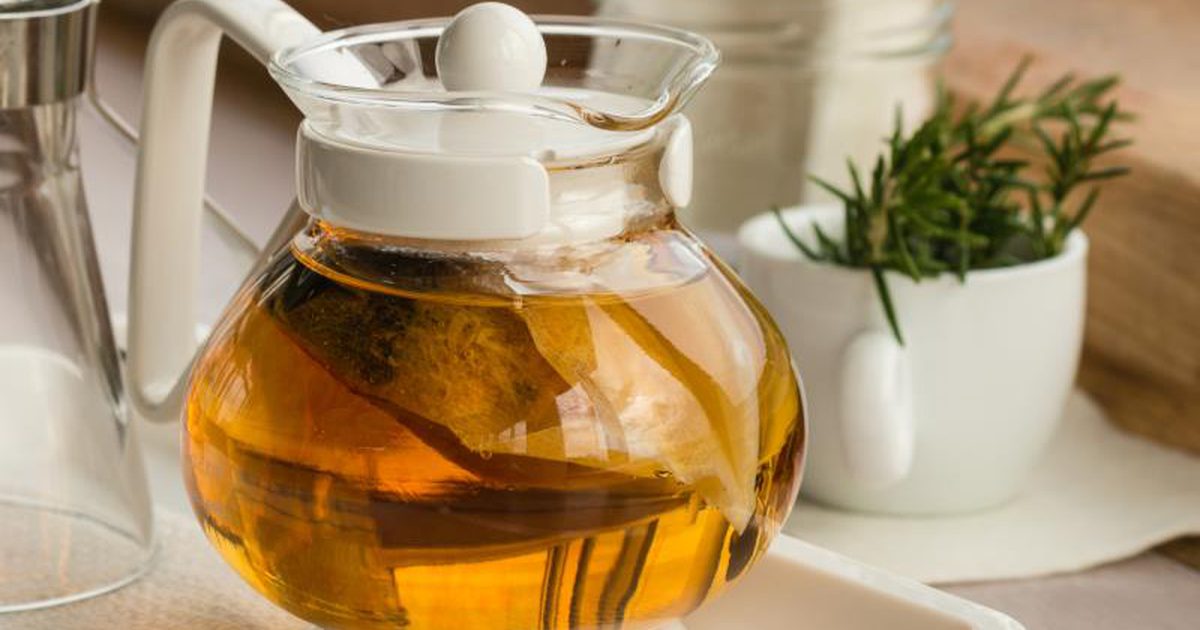If you are eager to know all about loose leaf tea, this is the ultimate blog for you.
Firstly, we provide a general overview of loose leaf tea and it’s almighty place within society.
We discuss the process of how loose tea is manufactured and the accompanying six stages: from plucking to the drying of tea.
From here, we highlight the various and most common types of loose leaf tea available on the market today.
Finally, and most importantly, we explain how to make the perfect brew.
Ready?
Page Glossary
Part 1) Tea Overview
Part 2)Tea Production Process
Part 3) Types of Loose Leaf Tea
Part 4) Best Brewing Techniques
Tea Overview
Tea is the second most consumed beverage in the world alongside water.
People drink tea from all sides of the world every day. In total, there are approximately 2,000 varieties in tea which all originate from the same plant, the camellia sinesis.
The Camilla sinesis is grown in Asia, Africa, India, South America and Australia.
It is primarily how the tea leaves are processed after harvest which will produce the different types of tea and their accompanying aromas and flavors.
The most common teas which are all produced from the Camilla sinesis plant include:
- White
- Green
- Black
- Oolong
Infusions or herbal tisanes such as chamomile, rose hip and lavender are herbs which are not technically tea.
This is because the ingredients of herbal teas do not originate from the camellia sinesis plant. Herbal tisanes are made from a number of plants and contain other aspects other than the leafs – such as: flowers, roots, bark and seed
There are 6 different stages in the tea production process:
1. Plucking

Tea leaves are plucked by hand and can vary between an unopened bud to the top three leaves and a bud.
Even though tea is plucked by hand, this process can also be carried out through mechanical picking but this depends entirely on the type of tea.
Tea harvesting is a delicate and concentrated process as their needs to be minimal damage to the tea leaves. Workers carry a basket or wear linen over their shoulder which helps them store the plucked leaves as they harvest.
In a nutshell: Tea leaves are plucked by hand and this process has to be done carefully.
2. Withering
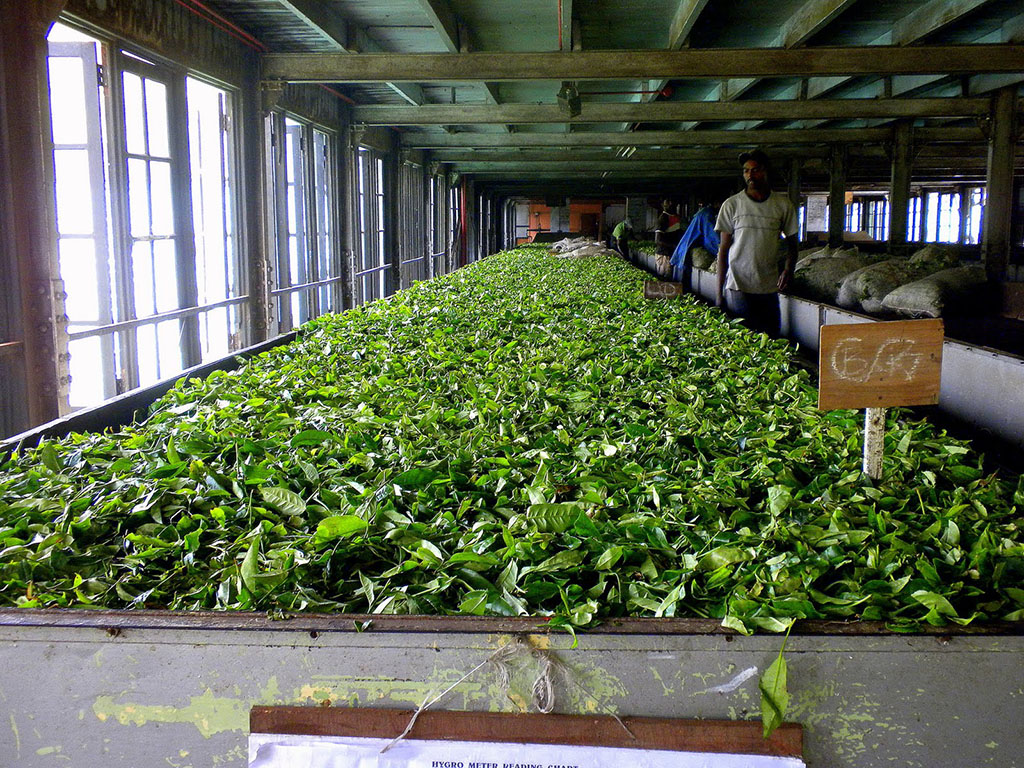
The goal of the withering process is to reduce the water content by 50 – 70%.
To extract the water from the tea leaves, the leaves can be withered in direct sunlight or inside dark and humid rooms.
The tea leaves are laid out to wilt and wither and are spread across laths which have jute, wire or nylon nets.
The withering process can take around 14-18 hours to complete.
The time it takes to complete depends entirely on the amount of humidity contained within the leaves and the type of flavor desired to be produced.
Withering Times:
- White: 12-36 hours
- Green: 2-4 Hours
- Black: 4-18 Hours
- Oolong: 30mins – 2 hours
In a nutshell: tea leaves are withered to reduce the amount of water content inside the tea leaves
3. Rolling

Previously, tea leaves were directly rolled by hand. Currently, tea leaves are now placed on a rolling machine which are used to cut open the tea leaves.
This process taking around 30 minutes and is executed 3 times. Once the tea leaves are rolled for 30 minutes, the full tea leaves are torn in thorn drums.
The general consensus is the more tightly rolled the tea leaves, the greater the freshness.
Ultimately, the rolling process produces enzymes and essential oils – kick starting the oxidation process.
In a nutshell: rolling helps kick start the oxidation process and is key to providing freshness
4. Oxidation
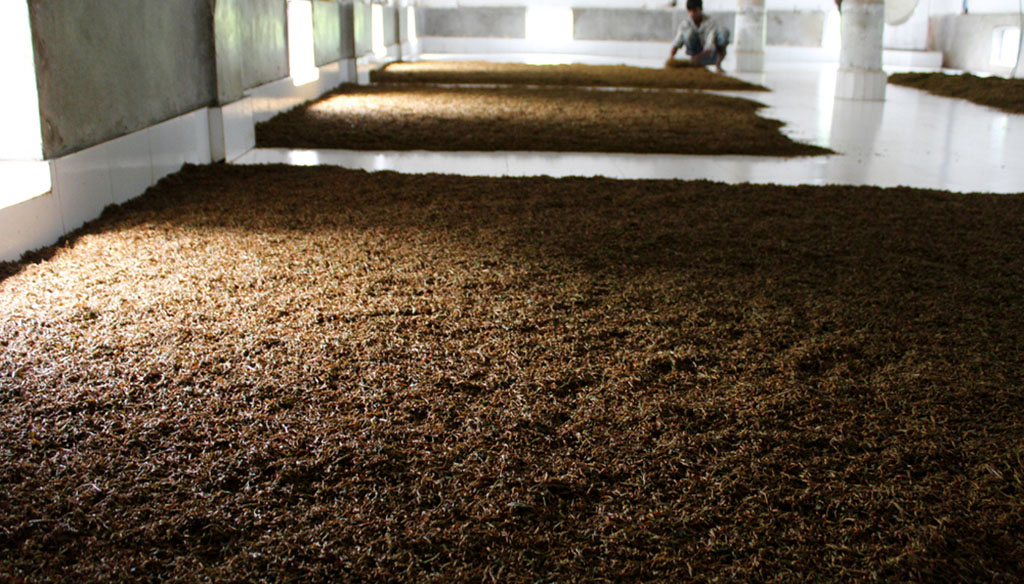
Oxidation is the chemical reaction that involves oxygen. The minute a tea leaf is plucked, it starts to passively oxidize and turn brown – much to the same process of when a banana is picked and eventually starts to turn brown.
However, during production, there is controlled oxidization where the tea leaves are put into rooms with a ‘controlled’ temperature of around 40c for up to three hours and lightly sprayed with water.
Through heat, you extract the oxygen from the tea leaves which halts the oxidation process.
The amount of time a leaf is put through the oxidation process depends on the type of tea desired to be produced from the leaf.
In a nutshell: oxidation turns the tea leaves darker.
When the oxidation process is prevented, the tea leaves keep their green color.
5. Drying

When the tea leaves have been oxidized to the correct level, they are put in humid rooms on tiered dryers.
The amount of time it takes to dry tea leaves depends on the amount of water content still inside the tea leaves.
To provide an example, oolong teas take around 5-10 minutes to dry whereas black teas can take 20-30 mins. Generally, tea leaves are dried for 20 minutes with air at a heat around 80 – 90c.
If the tea leaves are dried too quickly they can end up tasting too harsh.
A number of special teas, such as pu’erh, can be aged from months to years which makes the flavor more rich, much like the process of ageing wine.
Typical drying methods include:
- Pan Firing
- Steaming
- Tumblers
- Baking
In a nutshell: drying of the tea leaves helps to finalise the tea for sale
6. Sorting / Grading
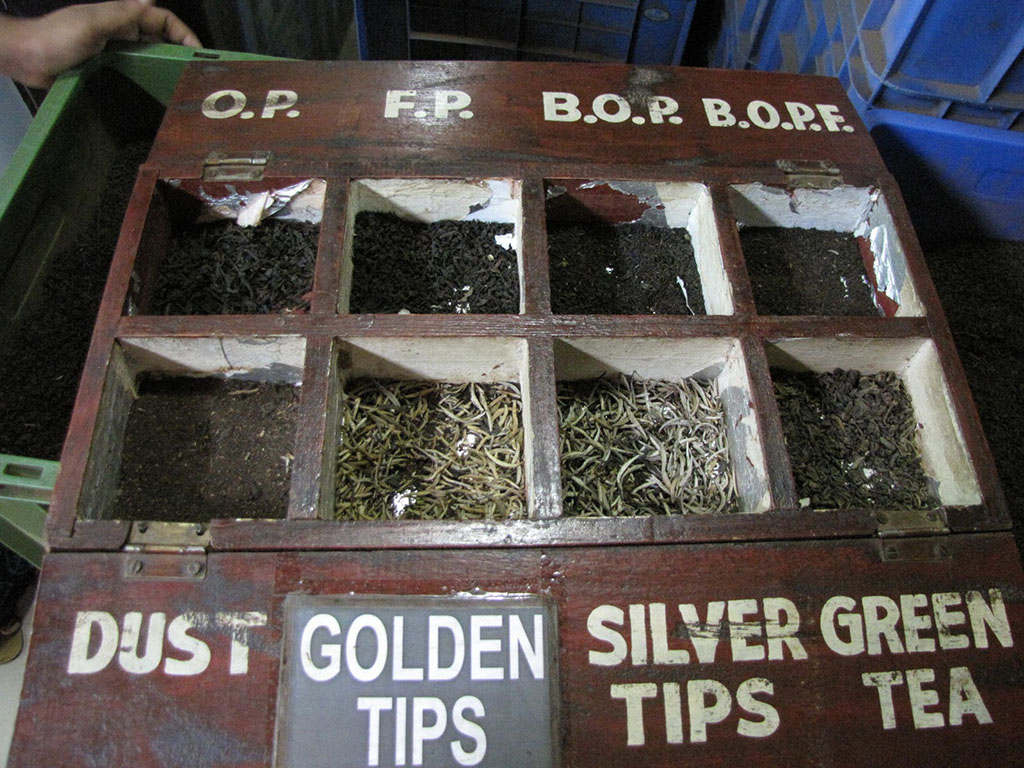
Once the tea process has been complete, the leaves are then sorted into different grades.
The different grades range from “orange pekoe” which is the highest quality ;and “dust” or “fannings” which are lower quality tea leaves.
In a nut shell: grading is important to determine which tea leaves are of higher quality.
This tea processing documentary by Lakshmi Rebecca explains how the humble tea leaf becomes golden tea in a cup.
Types of Loose Leaf Tea

White Tea
White tea is light, delicate, rare and undergoes the least amount of processing. The tea buds aren’t rolled or taken through factory methods of oxidization; and are lightly steamed and dried.
Thus, white tea is simply dried and not left to oxidize.
The most common types of white tea include:
- Sliver Needle
- White Peony
- Long Life Eyebrow
- Tribute Eyebrow
Green Tea
Green Tea is less oxidized because the leaves are quickly steamed after they have been withered and rolled. The lack of oxidization results in the leaves staying green.
This gentle process of heating the leaves first, preserves many of the vitamins and antioxidants of the tea leaves, thus why it’s known as a healthy drink.
The most common types of Green Tea include:
- Sencha
- Fukamushi Sencha
- Gyokuro
- Kabusecha
- Matcha
- Tencha
- Genmaicha
- Hojicha
- Shincha
- Ichibancha
- Nibancha
- Sanbancha
Infusions are often added to green teas and there are numerous types of flavors and colors.
For instance, you can find flavors like jasmine green tea, green tea with lemon or green tea with chocolate and orange.
Black Tea
Black tea leaves have been oxidized to the highest level and subsequently have high caffeine content. They are more oxidized than white, green and oolong teas.
During production, the tea leaves are withered and rolled and oxidized which results in the leaves turning dark.
They provide a strong flavor and are perfect to consume to get that early morning kick.
There are a number of popular black teas, including:
- Darjeeling
- Ceylon
- Assam
- Earl Grey
- Breakfast Tea
In particular, True Tea Club have their own concoction, known as an Earl Grey Rebel, which provides a rich taste of Assam leaves with bergamot and adroitly joins forces with orange flavoring.
Oolong
Oolong tea is partially oxidized and the tea leaves are withered in direct sunlight. Specifically, the tea leaves are picked, bruised and left to oxidize for a short duration.
The oxidation process is stopped when the leaves are between green and black tea. Oolong tea is smooth and known for its digestive benefits.
It’s been known to help in weight loss and the ability to reduce the risk of cancer, tooth decay and heart disease.
Aged Teas
Puerh
Puerh is a compressed post-oxidized tea which is typically aged for months or years. Much like a fine wine.
Puerh is also known as a tea brick, disc or other similar form which has been molded and pressed into a block.
The tea is processed and grown in the Lacang River of the Yunnang Province.
High quality puerh can be infused up to 60 times and is a dark liquor which provides a vast array of flavors.
It is believed to boost metabolism and help with weight loss.
Non-Camellia Sinesis Teas
Chai
Chai originates from India and is a popular spicy concoction which is served as a caffeinated black tea blend. As well as black tea, chai is made with herbs and spices.
These spices may include cardamom pods, cinnamon sticks, ground ginger and black peppercorn which all combine into a full bodied aromatic flavor.
To top off your cup off chai, try including milk, honey and sugar.
Roobios
Rooibos (also known as Red Bush or red Tea) is a caffeine-free tea which originates from the Cedarberg region near Capetown, South Africa.
In particular, rooibos is made from the red bush plant and comes from a shrub called the Aspalathus Linearis.
Rooibos lacks astringent tannings found in green and black teas. Some people, however, like to consume rooibos similar to Black tea and include milk & sugar.
Herbal
Herbal teas are not made from the leaves of a tea plant, but from dried fruits, flowers and berries of different herbs.
You can find an extensive range of herbal teas, including: chamomile, mint; and ginseng.
As well as having their own unique flavors, each herbal tea comes with individual benefits too.
Mate
Mate (also known as Yerba Mate) is made from the caffeinated tea leaves and twigs of the holly tree plant, Ilex Paraguariensis, based in South America.
It has been said that the leaves provide the “strength of coffee, the health benefits of tea, and the euphoria of chocolate”. The leaves are dried over a fire and then steeped in hot water.
Mate is traditionally consumed through a metal straw and a gourd. Mate has a grassy taste which is similar to green tea.
How To Brew Loose Leaf Tea
Most loose leaf teas do not require a long time to steep (i.e. be placed in boiling water).
It takes around 1 to 3 minutes for most teas to be fully optimized to their true flavor. When you steep tea longer than the recommended time frame, you may end up with a bitter taste.
For instance, some make the mistake of leaving their infuser in the tea pot; or their tea bag within the tea cup.
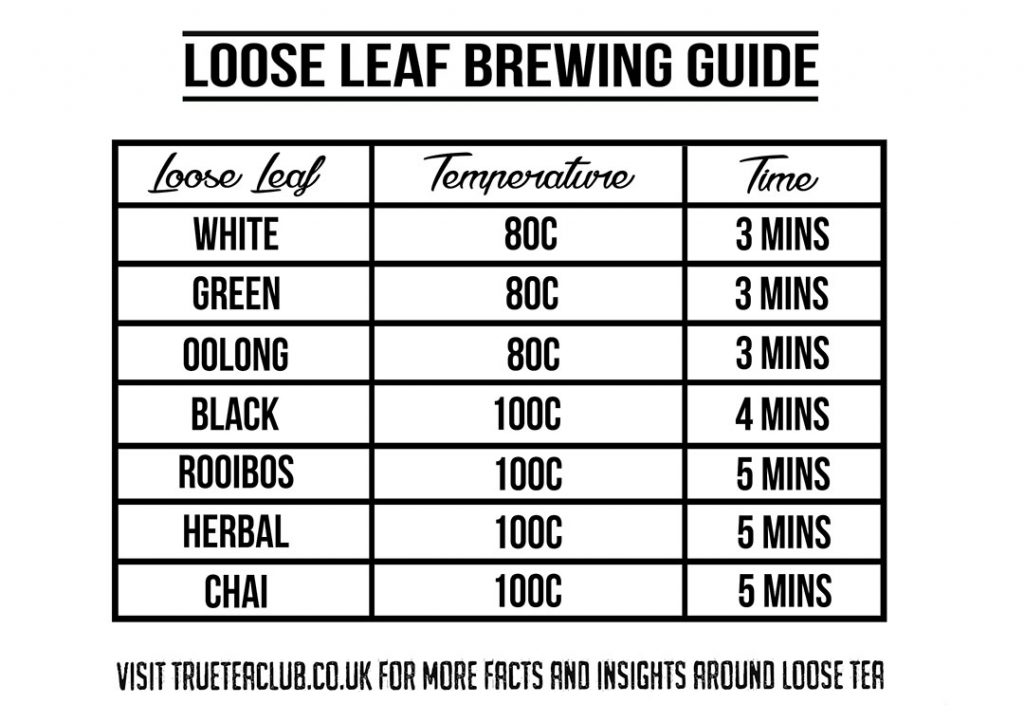
A number of essentials are needed / can be used when making loose tea:
Infuser
An infuser (also known as a tea ball or tea egg) is an item where you place one teaspoon of dried loose leaf tea inside.
You place the infuser into the cup of hot water and let tea leaves steep. It will help the tea leaves, such as fannings and broken tea leaves, from being left in your cup, which could result in your tea becoming too bitter or harsh.
It is important not to put too much tea inside the infuser as there needs to be enough room for the loose leaf to move freely.
Strainer
You place a strainer over a teapot or mug with the tea leaves inside.
As traditional methods include tea bags which hold the tea inside from escaping, strainers are used in the same manner.
Strainers are typically used for larger quantities of tea and are generally used in teapots.
Alongside this, strainers can be useful for tea that takes longer to infuse.
Vessel
As tea originated in Asia, there are vessels which are deemed more suitable than others in different regions.
For instance, the Japanese use tea pots which are produced from cast iron and are known as tetsubin teapots. In china, their vessels are made from unglazed clay known as yixing. And in Korea, they use teapots referred to as cha jujeonja which are glazed.
Not to mention, the British tend to use a glazed brown betty tea pot.
Brewing Instructions
Now you know all about loose leaf tea. It’s now time to make your own perfect brew.
Ingredients
- 1 tablespoon of loose leaf tea
- 6 Ounces of hot water (freshest water available)
Method
- Put the loose leaf into a strainer (or infuser)
- Boil the water to the correct temperature
- Pour hot water into the vessel
- Place the infuser inside
- Steep the tea for the recommended time (very important for optimum taste)
- Remove the filter/ or tea strainer (note: loose leafs can be reinfused)
- Add honey, lemon or milk (if desired)
Interested in trying loose leaf tea?
True Tea Club is a tea subscription company based in York, United Kingdom.
On the 20th of every month, we send out a different selection of four hand picked loose leaf teas. You will receive four individual pouches of fresh tea which can range from white, green, black; rooibos, oolong, puerh and herbal infusions.
A great benefit of subscribing with us is that you can choose the type of tea you prefer. Whether it might be delicate and aromatic, rich and fruity, or light and refreshing there’s something for everyone.
The amount of tea we send can vary from 40 to 80 cups of tea per month (dependent on your subscription package)
We offer Free UK delivery and charge £3.50 for worldwide international shipping.
There are no long standing commitments with your subscription at True Tea Club.
You can simply pause or cancel your tea subscription anytime.
Please view our dedicated subscription page for more information.

